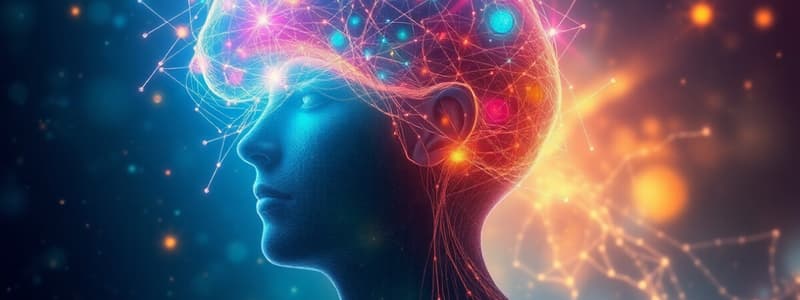Podcast
Questions and Answers
What does social neuroscience primarily focus on?
What does social neuroscience primarily focus on?
- The relationship between brain activity and social behavior (correct)
- The effects of cognitive biases on perception
- The influence of social contexts on individual thoughts
- The biological basis of mental processes
Which concept describes the interaction of biological and environmental factors in human behavior?
Which concept describes the interaction of biological and environmental factors in human behavior?
- Emotional intelligence
- Nature vs. Nurture debate (correct)
- Cognitive dissonance
- Social cognition
What does the Self-Referential Stimuli concept refer to?
What does the Self-Referential Stimuli concept refer to?
- Stimuli that evoke a strong emotional response
- External stimuli that affect social behavior
- Stimuli perceived as being related to oneself (correct)
- Memories that are triggered by external cues
Which of the following best describes the 'Mirror Test'?
Which of the following best describes the 'Mirror Test'?
What does the term 'Theory of Mind' refer to?
What does the term 'Theory of Mind' refer to?
What is the primary critique of the Mirror Test regarding non-visual species?
What is the primary critique of the Mirror Test regarding non-visual species?
Which brain region is thought to be crucial for self-awareness?
Which brain region is thought to be crucial for self-awareness?
What does the concept of 'Agency' refer to in the context of self-awareness?
What does the concept of 'Agency' refer to in the context of self-awareness?
What does the term 'Modularity Theories' suggest about Theory of Mind?
What does the term 'Modularity Theories' suggest about Theory of Mind?
What is the primary role of the right temporoparietal junction (TPJ)?
What is the primary role of the right temporoparietal junction (TPJ)?
Which statement accurately describes emotional empathy?
Which statement accurately describes emotional empathy?
Which brain areas are primarily involved in cognitive empathy?
Which brain areas are primarily involved in cognitive empathy?
What does the Social Pain/Physical Pain Overlap Theory (SPOT) propose?
What does the Social Pain/Physical Pain Overlap Theory (SPOT) propose?
What does the Negative-State Release Model suggest about altruism?
What does the Negative-State Release Model suggest about altruism?
Which game theory concept illustrates that people's decisions may not always be rational?
Which game theory concept illustrates that people's decisions may not always be rational?
How do mirror neurons function in predicting the actions or thoughts of others?
How do mirror neurons function in predicting the actions or thoughts of others?
Which brain region is primarily responsible for processing the unpleasant emotional response to pain?
Which brain region is primarily responsible for processing the unpleasant emotional response to pain?
What implication does the activation of the right ventral prefrontal cortex (RVPFC) have on pain regulation?
What implication does the activation of the right ventral prefrontal cortex (RVPFC) have on pain regulation?
What is a key characteristic of psychopathy in relation to empathy?
What is a key characteristic of psychopathy in relation to empathy?
What is the role of the anterior cingulate cortex (ACC) in social pain?
What is the role of the anterior cingulate cortex (ACC) in social pain?
Which type of empathy requires cognitive effort and is linked to executive functions?
Which type of empathy requires cognitive effort and is linked to executive functions?
What does the Simulation Theories concept emphasize in understanding others?
What does the Simulation Theories concept emphasize in understanding others?
In the context of altruism, what does kin selection refer to?
In the context of altruism, what does kin selection refer to?
What brain areas are activated during both the joy of giving and other rewarding experiences?
What brain areas are activated during both the joy of giving and other rewarding experiences?
What is a significant finding from the Cyberball task related to social exclusion?
What is a significant finding from the Cyberball task related to social exclusion?
Which of the following best encapsulates the concept of emotional contagion?
Which of the following best encapsulates the concept of emotional contagion?
In the context of mirror neuron activity, which statement is accurate?
In the context of mirror neuron activity, which statement is accurate?
What psychological model explains that people help others mainly to alleviate their own distress?
What psychological model explains that people help others mainly to alleviate their own distress?
Which brain region is linked to processing the unpleasant emotional response to physical pain?
Which brain region is linked to processing the unpleasant emotional response to physical pain?
Which levels of analysis interact within the social cognitive neuroscience prism?
Which levels of analysis interact within the social cognitive neuroscience prism?
What aspect does the False-belief task evaluate in children?
What aspect does the False-belief task evaluate in children?
What is a significant critique of the Mirror Test in assessing self-awareness?
What is a significant critique of the Mirror Test in assessing self-awareness?
Which component is NOT involved in the concept of self-awareness?
Which component is NOT involved in the concept of self-awareness?
In the context of the nature vs. nurture debate, what do researchers generally agree on?
In the context of the nature vs. nurture debate, what do researchers generally agree on?
Which aspect of self-awareness is associated with monitoring one's thoughts and actions?
Which aspect of self-awareness is associated with monitoring one's thoughts and actions?
What does the term 'Reductionism' imply in the context of social neuroscience?
What does the term 'Reductionism' imply in the context of social neuroscience?
Which statement best describes the role of the prefrontal cortex concerning self-awareness?
Which statement best describes the role of the prefrontal cortex concerning self-awareness?
Flashcards
Social Neuroscience
Social Neuroscience
The study of how brain activity relates to social behavior.
Social Psychology
Social Psychology
Study of how our thoughts and feelings are affected by other people.
Cognitive Neuroscience
Cognitive Neuroscience
Study of the brain’s role in mental processes.
Nature vs. Nurture
Nature vs. Nurture
Signup and view all the flashcards
Self-awareness
Self-awareness
Signup and view all the flashcards
Mirror Test
Mirror Test
Signup and view all the flashcards
Theory of mind
Theory of mind
Signup and view all the flashcards
False-belief task
False-belief task
Signup and view all the flashcards
Self-Referential Stimuli
Self-Referential Stimuli
Signup and view all the flashcards
Body Ownership
Body Ownership
Signup and view all the flashcards
Temporoparietal Junction (TPJ)
Temporoparietal Junction (TPJ)
Signup and view all the flashcards
Mirror Neurons
Mirror Neurons
Signup and view all the flashcards
Empathy
Empathy
Signup and view all the flashcards
Emotional Empathy
Emotional Empathy
Signup and view all the flashcards
Social Pain
Social Pain
Signup and view all the flashcards
Cyberball Task
Cyberball Task
Signup and view all the flashcards
Altruism
Altruism
Signup and view all the flashcards
Kin Selection
Kin Selection
Signup and view all the flashcards
Prisoner's Dilemma
Prisoner's Dilemma
Signup and view all the flashcards
Trust Game
Trust Game
Signup and view all the flashcards
Reductionism
Reductionism
Signup and view all the flashcards
Social Cognitive Neuroscience Prism
Social Cognitive Neuroscience Prism
Signup and view all the flashcards
Modularity Theories
Modularity Theories
Signup and view all the flashcards
Agency
Agency
Signup and view all the flashcards
Simulation Theory
Simulation Theory
Signup and view all the flashcards
Cognitive Empathy
Cognitive Empathy
Signup and view all the flashcards
Anterior Cingulate Cortex (ACC)
Anterior Cingulate Cortex (ACC)
Signup and view all the flashcards
Study Notes
Social Neuroscience and Related Concepts
- Social Neuroscience: Studies the relationship between brain activity and social behavior.
- Social Psychology: Examines how thoughts and feelings are affected by others' presence.
- Cognitive Neuroscience: Investigates the brain's role in mental processes.
- Nature vs. Nurture: Debate on whether environment or biology shapes us; the interaction of both is accepted as the most accurate.
- Reductionism: Researchers avoid reducing complex phenomena to simple biological components.
- Social Cognitive Neuroscience Prism: Illustrates the interplay of biological, psychological, social, and cultural factors in social behavior.
Self-Awareness
- Self-Awareness: Ability to reflect on one's own traits, beliefs, abilities, and attitudes.
- Mirror Test: Used to assess self-awareness in animals (elephants, dolphins, fish); controversial due to potential inaccuracies for species relying on non-visual senses.
- Olfactory Mirror Test: Proposed for dogs, suggesting a potential for self-awareness.
- Prefrontal Cortex: Believed to be crucial for self-awareness.
- Self-Referential Stimuli: Stimuli relating to oneself.
- Representation: Organizing self-related information (traits, skills).
- Evaluation: Determining internal vs. external origins of stimuli (e.g., inner voice vs. external voice).
- Monitoring: Detecting errors, making choices, overriding habits.
- Integration: Combining traits, goals, values, and memories into a unified self-concept.
- Agency: Feeling of being the cause of one's thoughts and actions.
- Body Ownership: Perception of one's own body.
Theory of Mind and Empathy
-
Theory of Mind: Ability to understand others' mental states (emotions, beliefs, intentions).
-
False-Belief Task: Measures a child's grasp that others can have different beliefs.
-
Modularity Theories: Propose an innate, specialized module in the brain for theory of mind (TPJ - Temporoparietal Junction). The right TPJ is more deeply involved than the left one.
-
Temporoparietal Junction (TPJ): Play a key role in social and cognitive functions, attention reorientation, empathy, and agency.
-
Simulation Theories: Suggest we understand others by mentally putting ourselves in their shoes.
-
Mirror Neurons: Activated by observing others' actions (externally); also active when planning our own actions (internally). Four steps involve execution/observation of actions for prediction, mirror neuron activation via action observation, externally triggered motor neuron activity does not cause action in observer, and beliefs/intentions are attributed to person observed
-
**Executive Theory:**Theory of mind relies on the ability to suppress own thoughts/actions.
-
Empathy: Ability to understand and share another's feelings.
-
Emotional Empathy: Automatic emotional responses to others' emotions (emotional contagion); perception-action model involved (when we perceive one's emotional state, its actions and their representations related to the emotions are triggered in your brain).
-
Cognitive Empathy: Adopting another's perspective to infer their emotional state (cognitive effort needed).
-
Brain Areas Involved (Emotional Empathy): Anterior cingulate cortex (ACC), inferior frontal gyrus (IFG), inferior parietal lobule.
-
Brain Areas Involved (Cognitive Empathy): VMPFC/DMPFC, medial temporal lobe, superior temporal sulcus, and temporal poles.
Components of Physical Pain
- Perceptual Dimension (Physical Pain): Detection of the pain (Insula + Somatosensory cortex).
- Affective Dimension (Physical Pain): Unpleasant emotional response to pain (ACC).
Pain Regulation
- Regulation of Pain: Strategies individuals use to cope with pain (RVPFC).
Social Pain
- Social Exclusion: Lack of social interaction.
- Cyberball Task: fMRI study showing social exclusion activates areas related to the affective dimension of physical pain (ACC), similar to those involved in physical pain regulation (RVPFC).
- SPOT Theory (Social Pain Overlap Theory): Neural overlap between social and physical pain.
Altruism and its Neural Basis
- Altruism: Helping behavior for the good of others.
- Kin Selection: Tendency to help relatives.
- Reciprocal Altruism: Helping others with the expectation of future return.
- Negative-State Relief Model: Helping others to reduce our own feelings of distress.
- Cost-Benefit Analysis: Helping only when the costs are lower than benefits.
- Joy of Giving: Similar brain areas activated as for other rewards (e.g., VTA, dorsal/ventral striatum).
Psychopaths and Neural Deficits
- Psychopaths: Lack empathy, remorse, guilt.
- Amygdala: Often shows smaller size, damage or lower activity.
Cooperation, Trust, and Game Theory
- Game Theory: Mathematical approach used to explain animal and human behavior in social/political contexts.
- Prisoner's Dilemma: Game that illustrates how cooperation and selfishness intersect. (defecting: prioritizes individual gain, cooperating: mutual benefit)
- Trust Game: Game illustrating trust through investment.
Studying That Suits You
Use AI to generate personalized quizzes and flashcards to suit your learning preferences.
Description
Test your knowledge on social neuroscience and the concept of self-awareness. This quiz covers key terms and theories on how brain activity relates to social behavior, cognitive processes, and the intricacies of self-reflection. Explore the debates surrounding nature vs. nurture and reductionism in psychology.




